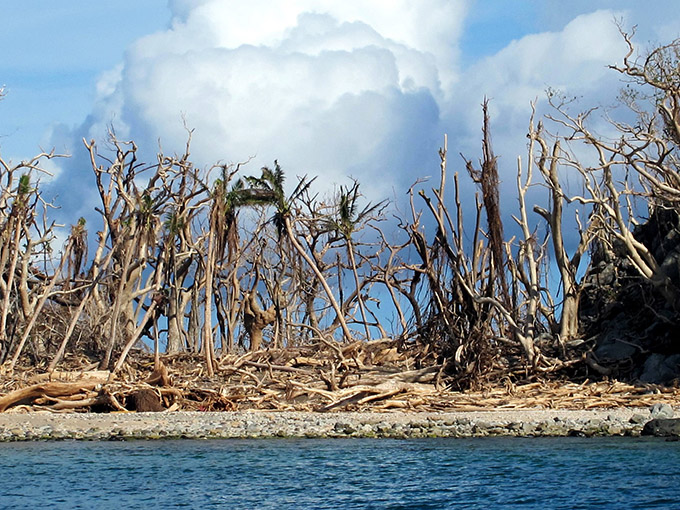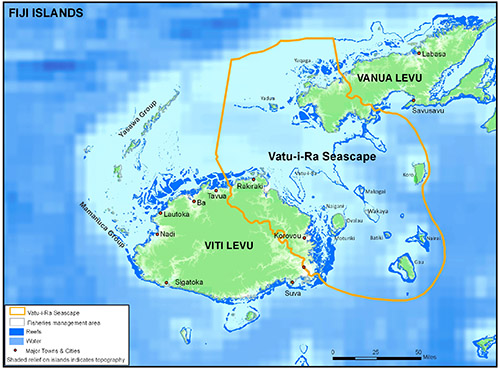
Almost two months following the most devastating cyclone to have ever hit Fiji, the country’s people and biodiversity are still struggling towards recovery, Anuja Nadkarni files for Asia Pacific Report.
Recurring climate change patterns have not only impacted on the communities and landscapes of Fiji but also caused significant damage to the seascape of one of the nation’s pristine wild places – Vatu-i-ra Island.
![]() The director of the Fiji Programme for Wildlife Conservation Society, Dr Sangeeta Mangubhai, has been studying the coral reefs in the Vatu-i-ra seascape, located between Fiji’s two large islands, Viti Levu and Vanua Levu.
The director of the Fiji Programme for Wildlife Conservation Society, Dr Sangeeta Mangubhai, has been studying the coral reefs in the Vatu-i-ra seascape, located between Fiji’s two large islands, Viti Levu and Vanua Levu.
Dr Mangubhai’s report on the impact of cyclone Winston on Vatu-i-ra revealed that the strong winds and waves affected coral reefs up to 30m below the surface of the sea.

“Vatu-i-ra Island has a regionally significant seabed population and there is just no vegetation on the leaves so we’re not sure what it is going to do to the seabed population because they need shade and shelter to live there.”
Coral regeneration is a slow process and the report shows that frequent extreme weather events combined with other effects of climate change could take the reefs decades to recover.
“It’s hard because these reefs are already suffering from issues like overfishing… but now they’ve received stress to their physiology, coral loss, coral damage, stress of sea surface temperatures – that combination has led to corals probably aborting their reproduction this year,” Dr Mangubhai says.
Oxfam New Zealand’s senior campaigns and communications specialist Jason Garman says climate changed has caused rising sea temperatures and an increase in pH levels known as ocean acidification. As Garman explains, this phenomenon has led to developments such as coral bleaching.
‘Garden of Eden’
“Coral reefs are the Garden of Eden of life in the sea…this is where the vast majority of the biodiversity will be, so when the coral reefs die then all of those fish no longer have the food source they need and the fish die out or move to another area where they can live.
“Climate change is driving ocean acidification, shellfish are no longer able to create their shells because the water is so acidic that it disintegrates the shell this is also what is driving coral bleaching,” Garman says.
Dr Mangubhai’s research has also identified coral bleaching in the Vatu-i-ra seascape, with some areas experiencing up to 20 percent of bleaching as a result of increased ocean temperatures from the El Niño cycle.
Garman says the trends of El Niño are increasing in severity as a result of climate change and says scientists expect this phenomenon to get worse.
“El Niño has been going on for eons and the problem is that El Niño is caused by a rise in the surface temperature of the oceans in the southern Pacific and the higher the temperature the stronger the weather event is.
“In the past we had very strong cyclones perhaps every 50 years to 100 years but what we’re seeing right now is that those once in a lifetime storms are becoming nearly an annual event.”
Increasing storms
UNICEF Suva’s communication specialist Alice Clements says an increased prevalence of storms is something that involves climate adaptation.
“Since 1970 there have been 11 category five cyclones and two of those have been in the span of 12 months with cyclone Pam in Vanuatu and cyclone Winston in Fiji so we know that things are changed. Fiji has done a phenomenal response to this emergency, they’ve been incredibly organised and they’ve done it quickly.
“In the past something like this would’ve been a shock or something out of the blue but these days they can anticipate that there might be a strong storm coming at some point in their life.”
Climate change adviser for the Secretariat of the Samoa based Pacific Regional Environment Programme (SPREP) Herman Timmermans says communities and the ecosystems they depend on for everyday goods and services and livelihoods will be more severely impacted on by more intense cyclones and recovery times will be longer.
Timmermans says that the socio-economic and environmental benefits derived are also much greater.
Although Dr Mangubhai’s report did not cover a visual census of the coral reef fish populations, it revealed that semi-pelagic fish and sharks seemed largely unaffected.
Also based on data collected on how the Australian Great Barrier Reef’s recovery from previous cyclone damage, Dr Mangubhai expects the productivity of fisheries to decrease.
Fisheries damage
“The fisheries in the area are valued at more than F$24 million (NZ$16.7 million) – there will obviously be a decline from that, but we don’t know by how much until we understand fully the scale of damage to fisheries in the region.
“Fish need time for the corals to come back to provide that habitat for them to move around and find new homes.”
She says although cyclone Zena — which hit Fiji earlier this month — was a relatively milder category two, it was expected to move the rubble around and cause more abrasions to the corals.
Dr Mangubhai says while rehabilitation of coral reefs is expected to be very expensive, the best option to minimise further impact to the region’s sea life is reduce fishing pressure on the reefs. But she says that is a difficult proposition considering fish is the staple diet of local populations.
“There’s a real challenge between communities now – they need to continue to fish for food security and some of them are going to be under more pressure to fish out their resources for money.
“Then it’s also got a bleaching event sitting on top of a cyclone event so it’s even more than they normally experience and they’re going to need space to recover and it’s really going to depend on how much we can reduce that pressure for the next couple of years, give those corals a chance to come back before we can come back to the same level to be explored again.”
Anuja Nadkarni is a journalism graduate from AUT and is currently completing her Honours degree in Communication Studies. She is on the Asia-Pacific Journalism Studies course.










































Good Story Anuja
Comments are closed.